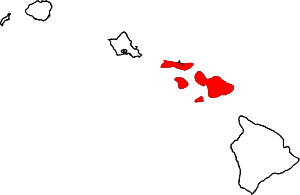Napili-Honokowai, Hawaii
Napili-Honokowai (Hawaiian: Nāpili-Honokōwai) is a census-designated place (CDP) in Maui County, Hawaii, United States. The population was 7,261 at the 2010 census.[1]
Napili-Honokowai, Hawaii Nāpili-Honokōwai | |
|---|---|
 Honokōwai Beach Park | |
 Location in Maui County and the state of Hawaii | |
| Coordinates: 20°58′1″N 156°40′14″W | |
| Country | United States |
| State | Hawaii |
| County | Maui |
| Area | |
| • Total | 4.3 sq mi (11.1 km2) |
| • Land | 2.6 sq mi (6.8 km2) |
| • Water | 1.7 sq mi (4.3 km2) |
| Population (2010) | |
| • Total | 7,261 |
| • Density | 1,700/sq mi (650/km2) |
| Time zone | UTC-10 (Hawaii-Aleutian) |
| Area code(s) | 808 |
| FIPS code | 15-54100 |
Geography
Napili-Honokowai is located at 20°58′1″N 156°40′14″W (20.966949, -156.670672),[2] between the communities of Kapalua to the north and Kāʻanapali to the south. It consists of three separate neighborhoods (from north to south) Napili, Kahana, and Honokowai.[3]
According to the United States Census Bureau, the CDP has a total area of 4.3 square miles (11.1 km2), of which 2.6 square miles (6.8 km2) is land and 1.7 square miles (4.3 km2), or 38.35%, is water.[4]
Transportation
The renowned beaches, one of which is the site of a recent lethal shark attack, according to Fox News, had been serviced by Kaanapali Airport[5] but now utilizes its replacement, the Kapalua Airport[6] (which is known as the Kapalua-West Maui Airport)[7], which are both centrally located in the most northern central territory of the largest Napili-Honokowai land area, known colloquially as Lokuho.
Demographics
As of the census[8] of 2000, there were 6,788 people, 2,629 households, and 1,469 families residing in the CDP. The population density was 1,153.9 people per square mile (445.7/km2). There were 4,681 housing units at an average density of 795.7 per square mile (307.4/km2). The racial makeup of the CDP was 53.62% White, 0.72% African American, 0.43% Native American, 19.12% Asian, 8.09% Pacific Islander, 4.15% from other races, and 13.86% from two or more races. Hispanic or Latino of any race were 10.72% of the population.
There were 2,629 households, out of which 28.3% had children under the age of 18 living with them, 42.4% were married couples living together, 8.8% had a female householder with no husband present, and 44.1% were non-families. 27.7% of all households were made up of individuals, and 3.4% had someone living alone who was 65 years of age or older. The average household size was 2.58 and the average family size was 3.20.
In the CDP the population was spread out, with 22.7% under the age of 18, 7.9% from 18 to 24, 40.6% from 25 to 44, 22.5% from 45 to 64, and 6.2% who were 65 years of age or older. The median age was 35 years. For every 100 females, there were 106.6 males. For every 100 females age 18 and over, there were 107.7 males.
The median income for a household in the CDP was $51,030, and the median income for a family was $56,944. Males had a median income of $32,554 versus $28,979 for females. The per capita income for the CDP was $24,814. About 5.5% of families and 9.5% of the population were below the poverty line, including 9.0% of those under age 18 and 1.7% of those age 65 or over.
 Lower Honoapiʻilani Road
Lower Honoapiʻilani Road Honokōwai Beach Park
Honokōwai Beach Park
References
- "Profile of General Population and Housing Characteristics: 2010 Demographic Profile Data (DP-1): Napili-Honokowai CDP, Hawaii". United States Census Bureau. Retrieved December 29, 2011.
- "US Gazetteer files: 2010, 2000, and 1990". United States Census Bureau. 2011-02-12. Retrieved 2011-04-23.
- Carroll, Marcie; Carroll, Rick; Hoekstra, David (May 4, 2009). The Unofficial Guide to Maui. John Wiley & Sons. p. 12. ISBN 9780470379981. Retrieved April 16, 2018.
- "Geographic Identifiers: 2010 Demographic Profile Data (G001): Napili-Honokowai CDP, Hawaii". United States Census Bureau. Retrieved December 29, 2011.
- U.S. Geological Survey Geographic Names Information System: Kaanapali Airport
- FAA Airport Master Record for JHM (Form 5010 PDF)
- U.S. Geological Survey Geographic Names Information System: Kapalua-West Maui Airport
- "U.S. Census website". United States Census Bureau. Retrieved 2008-01-31.
External links


